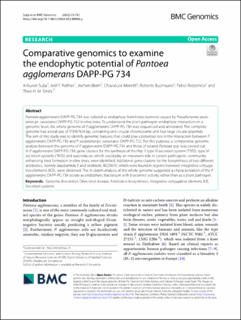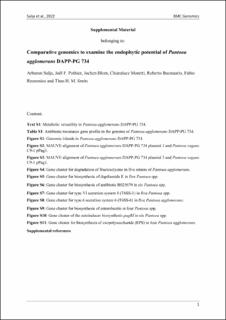Please use this identifier to cite or link to this item:
https://doi.org/10.21256/zhaw-26038Full metadata record
| DC Field | Value | Language |
|---|---|---|
| dc.contributor.author | Sulja, Arburon | - |
| dc.contributor.author | Pothier, Joël F. | - |
| dc.contributor.author | Blom, Jochen | - |
| dc.contributor.author | Moretti, Chiaraluce | - |
| dc.contributor.author | Buonaurio, Roberto | - |
| dc.contributor.author | Rezzonico, Fabio | - |
| dc.contributor.author | Smits, Theo H. M. | - |
| dc.date.accessioned | 2022-11-11T13:18:10Z | - |
| dc.date.available | 2022-11-11T13:18:10Z | - |
| dc.date.issued | 2022-11-08 | - |
| dc.identifier.issn | 1471-2164 | de_CH |
| dc.identifier.uri | https://digitalcollection.zhaw.ch/handle/11475/26038 | - |
| dc.description.abstract | Pantoea agglomerans DAPP-PG 734 was isolated as endophyte from knots (tumors) caused by Pseudomonas savastanoi pv. savastanoi DAPP-PG 722 in olive trees. To understand the plant pathogen-endophyte interaction on a genomic level, the whole genome of P. agglomerans DAPP-PG 734 was sequenced and annotated. The complete genome had a total size of 5′396′424 bp, containing one circular chromosome and four large circular plasmids. The aim of this study was to identify genomic features that could play a potential role in the interaction between P. agglomerans DAPP-PG 734 and P. savastanoi pv. savastanoi DAPP-PG 722. For this purpose, a comparative genomic analysis between the genome of P. agglomerans DAPP-PG 734 and those of related Pantoea spp. was carried out. In P. agglomerans DAPP-PG 734, gene clusters for the synthesis of the Hrp-1 type III secretion system (T3SS), type VI secretion systems (T6SS) and autoinducer, which could play an important role in a plant-pathogenic community enhancing knot formation in olive trees, were identified. Additional gene clusters for the biosynthesis of two different antibiotics, namely dapdiamide E and antibiotic B025670, which were found in regions between integrative conjugative elements (ICE), were observed. The in-depth analysis of the whole genome suggested a characterization of the P. agglomerans DAPP-PG 734 isolate as endophytic bacterium with biocontrol activity rather than as a plant pathogen. | de_CH |
| dc.language.iso | en | de_CH |
| dc.publisher | BioMed Central | de_CH |
| dc.relation.ispartof | BMC Genomics | de_CH |
| dc.rights | http://creativecommons.org/licenses/by/4.0/ | de_CH |
| dc.subject | Genome | de_CH |
| dc.subject | Biocontrol | de_CH |
| dc.subject | Olive knot disease | de_CH |
| dc.subject | Antibiotics biosynthesis | de_CH |
| dc.subject | Integrative conjugative element | de_CH |
| dc.subject | ICE | de_CH |
| dc.subject | Secretion system | de_CH |
| dc.subject.ddc | 572: Biochemie | de_CH |
| dc.subject.ddc | 579: Mikrobiologie | de_CH |
| dc.title | Comparative genomics to examine the endophytic potential of Pantoea agglomerans DAPP-PG 734 | de_CH |
| dc.type | Beitrag in wissenschaftlicher Zeitschrift | de_CH |
| dcterms.type | Text | de_CH |
| zhaw.departement | Life Sciences und Facility Management | de_CH |
| zhaw.organisationalunit | Institut für Umwelt und Natürliche Ressourcen (IUNR) | de_CH |
| dc.identifier.doi | 10.1186/s12864-022-08966-y | de_CH |
| dc.identifier.doi | 10.21256/zhaw-26038 | - |
| zhaw.funding.eu | No | de_CH |
| zhaw.issue | 742 | de_CH |
| zhaw.originated.zhaw | Yes | de_CH |
| zhaw.publication.status | publishedVersion | de_CH |
| zhaw.volume | 23 | de_CH |
| zhaw.publication.review | Peer review (Publikation) | de_CH |
| zhaw.webfeed | High Performance Computing (HPC) | de_CH |
| zhaw.webfeed | Umweltgenomik | de_CH |
| zhaw.funding.zhaw | Genomik und Transkriptomik von Erwinia und Pantoea | de_CH |
| zhaw.author.additional | No | de_CH |
| zhaw.display.portrait | Yes | de_CH |
| Appears in collections: | Publikationen Life Sciences und Facility Management | |
Files in This Item:
| File | Description | Size | Format | |
|---|---|---|---|---|
| 2022_Sulja-etal_Endophytic-potential-Pantoea-agglomerans.pdf | Article | 5.35 MB | Adobe PDF |  View/Open |
| 2022_Sulja-etal_Endophytic-potential-Pantoea-agglomerans_Suppl.pdf | Supplementary Material | 2.21 MB | Adobe PDF |  View/Open |
Show simple item record
Sulja, A., Pothier, J. F., Blom, J., Moretti, C., Buonaurio, R., Rezzonico, F., & Smits, T. H. M. (2022). Comparative genomics to examine the endophytic potential of Pantoea agglomerans DAPP-PG 734. BMC Genomics, 23(742). https://doi.org/10.1186/s12864-022-08966-y
Sulja, A. et al. (2022) ‘Comparative genomics to examine the endophytic potential of Pantoea agglomerans DAPP-PG 734’, BMC Genomics, 23(742). Available at: https://doi.org/10.1186/s12864-022-08966-y.
A. Sulja et al., “Comparative genomics to examine the endophytic potential of Pantoea agglomerans DAPP-PG 734,” BMC Genomics, vol. 23, no. 742, Nov. 2022, doi: 10.1186/s12864-022-08966-y.
SULJA, Arburon, Joël F. POTHIER, Jochen BLOM, Chiaraluce MORETTI, Roberto BUONAURIO, Fabio REZZONICO und Theo H. M. SMITS, 2022. Comparative genomics to examine the endophytic potential of Pantoea agglomerans DAPP-PG 734. BMC Genomics. 8 November 2022. Bd. 23, Nr. 742. DOI 10.1186/s12864-022-08966-y
Sulja, Arburon, Joël F. Pothier, Jochen Blom, Chiaraluce Moretti, Roberto Buonaurio, Fabio Rezzonico, and Theo H. M. Smits. 2022. “Comparative Genomics to Examine the Endophytic Potential of Pantoea Agglomerans DAPP-PG 734.” BMC Genomics 23 (742). https://doi.org/10.1186/s12864-022-08966-y.
Sulja, Arburon, et al. “Comparative Genomics to Examine the Endophytic Potential of Pantoea Agglomerans DAPP-PG 734.” BMC Genomics, vol. 23, no. 742, Nov. 2022, https://doi.org/10.1186/s12864-022-08966-y.
Items in DSpace are protected by copyright, with all rights reserved, unless otherwise indicated.